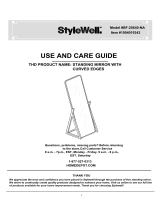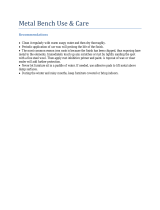
Product Care Information
Thank you for your purchase! Your new outdoor living sets and accessories are designed for many years
of enjoyment with proper care. Please adopt the following practices to ensure the longevity of your
purchase.
General Cleaning
Regular cleaning should be done with a damp, non-colored, non-abrasive cloth soaked in clear water.
Use mild soap as necessary. Avoid the use of abrasive cleaners and power washers. Clean spills
immediately with a damp, non-colored, non-abrasive cloth and mild soap solution to avoid staining.
General Care and Maintenance
To protect the finish of painted metal products from scratches, dulling, and wear and tear, apply a clear
coat, such as an epoxy clear coat, at least once per year. If the finish becomes scratched or chipped,
move quickly to apply touch up paint to avoid exposure of the underlying metal to the elements. Lightly
sand the area to be painted with 600 grit or finer sandpaper. Wipe the area clean. Then, hold the paint
can 8-10 inches away from the surface and sweep the area applying a thin coat of paint each pass. Allow
the paint to dry between each coat. Alternatively, you may apply paint to a separate surface then use a
small brush to touch-up the scratched area. If you are repairing a finish that consists of more than one
color, first apply the base coat, then apply the highlight color using a small brush, per the methods
described above. You may want to test on a piece of cardboard or other surface before working on the
product. Touch up paint is available for purchase from the number below.
Tubular/cast iron products will eventually rust. More frequent maintenance and application of clear
coats, covering the sets when not in use to protect from exposure, and especially prompt attention to
scratches or chips will prolong the life of iron sets. However, because of the nature of iron, it will
eventually rust when exposed to humidity and/or the elements. Rusting or oxidation is not covered
under the Limited Warranty.
Using the product in a coastal environment places higher demand on the surface finish due to the
effects of salty/corrosive air. More frequent cleaning (weekly or biweekly) is necessary to remove any
buildup of salt residue. Quarterly application of a clear coat is necessary to maintain a strong surface
finish in this type of environment.
For all items, avoid exposure, especially prolonged exposure to harsh environments including rain, snow,
or other wet conditions, direct sunlight, extremely high or low temperatures, and salty or corrosive air.
Products should be covered or brought indoors when not in use, especially when not in use for
prolonged periods of time, or when otherwise exposed to harsh weather such as winter. Do not put hot
items directly on furniture surface. Always use coasters, placemats, trivets, or hot pads. Do not clean
with harsh cleaners or polish. Do not place near heating or cooling vents. Do not write on furniture
without a padded barrier to protect the surface. To prolong the product lifetime, avoid extended and
lengthy exposure to direct rain or sunshine. All products are for residential use only. Not for commercial
use.

Additional Care for Stainless Steel Products
If stains or rust are to occur on stainless steel, promptly clean the deposit. Stains left unaddressed can
become permanent.
Clean by using a non-abrasive stainless steel cleaner / polish. Make sure to follow the cleaner
manufacturer’s instructions. Test in a small inconspicuous spot to ensure original finish isn’t affected.
When applying, remember to rub in the same direction as the metal grain. Rinse furniture thoroughly
with clean water. Lastly, dry thoroughly by wiping along with the grain.
Additional Care for Paint Finishes
This care is directed specifically to aluminum products such as: bird baths, stepping stones, statues,
urns, seating, tables and umbrellas. Periodically clean the finish with a soft sponge or washcloth using a
cleaning solution with ¼ cup mild liquid soap mixed in a gallon of lukewarm water. Rinse thoroughly and
avoid abrasive cleaners. As for glossy finishes, we recommend waxing the finish with a high grade
automotive paste wax or any commercially available protectant to help maintain and/or restore luster
of the finish.
Additional Care for Fabric
Clean all spills promptly. Fabric life can easily be extended by just simply wiping down your cushions,
pillows, etc, with a damp washcloth regularly. Some suntan and sun block products can permanently
discolor any fabric. If cleaned immediately, this can greatly reduce the possibility of damage. In addition,
storing the cushions when not in use can extend the life of the fabric.
Prepare a cleaning solution by mixing ¼ cup of mild liquid soap into a gallon of lukewarm water. Clean
fabric with solution by using a soft sponge or washcloth. Do not forget to rinse the fabric with clean
water once done applying the solution. Finally, allow the fabric to air dry. Standing a cushion on its edge
will allow it to dry faster.
Additional Care for Wicker
For small stains on outdoor wicker furniture, use a mixture of ¼ cup of mild liquid soap in a gallon of
lukewarm water and a soft cloth or sponge to wipe the stain. Then rinse away the soapy suds with clear
water. For mold and mildew removal, add one cup of white vinegar to the solution.
For tough stains, use the same solution above in combination with a soft brush. This will help you get
into the nooks and crannies. Once all dirt and debris are scrubbed away, rinse thoroughly with plain
water and dry thoroughly.
How to Avoid Damage to Wicker
Be careful when handling it, do not press too hard on its slats.
If slats get broken or damaged, repair them by using the appropriate glue based on the material.
Allow ample time for the glue to dry before continuing to clean.
Do not use a stiff brush, a steel wool pad, or any hard abrasives on wicker.
Don’t let water pool on wicker, the moisture can result in spotting, deformity, or both.

Additional Care for Stone Products
Stone is a durable yet porous material. Acidic compounds found in many foods such as tomato products,
mustard, fruit juices, wines, colas, vinegar, and coffee can leave permanent stains or marks in stone
material. The porous nature of stone also leaves it susceptible to heat retention. Care should be
exercised when handling stone that has been subjected to lengthy exposure to the sun.
Regularly clean your stone table top with a soft, clean, non-colored cloth, warm clean water, and mild
dish soap to prevent dirt and debris from settling in and leaving stains or discolorations. Do not use
petroleum-based, ammonia-based, acid based (citrus, pine, or vinegar cleaners), alkaline-based (baking
soda, borax) or abrasive cleaners. Dry thoroughly after cleaning. Clean spills immediately with blotting
motions as wiping could spread the spill. Repeat blotting with dry area of cloth until spill is totally
absorbed. Rinse with clean, warm water and wipe dry.
Sealing is the most important thing you can do to ensure the lasting beauty of your stone tabletop.
Tables with stone features should be protected from liquid penetration and wear and tear with an
application of stone sealer every 6 to 12 months, after it has been thoroughly cleaned, or more often if
used in harsh environments or in heavy usage conditions. The sealer should be applied to the stone and
surrounding grout. The purpose of the sealer is to help repel water and stains from the surface,
preventing absorption of moisture and stainable liquids. Liquid/moisture penetration is harmful to
natural stone and grout and can cause permanent damage including chipping, cracking, pitting,
spallation, discoloration, and staining. Stone sealers are available at most hardware stores. Follow the
manufacturers’ instructions for applying sealer.
Cover your set with an outdoor furniture cover when not in use to protect it from the elements,
extremely high and low temperatures, direct sunlight, rain, snow, or other wet conditions, and salty or
corrosive air. Furniture covers can be purchased at most patio shops and home improvement centers.
We recommend that your stone table be stored indoors in a dry area when not in use, especially during
the winter months to protect it from the extreme cold. If it must be stored outside, it should always be
covered. Make a tent with the cover so that it is not touching any part of the tabletop, as this will
promote airflow and allow moisture to escape. Snow or moisture sitting on a tabletop for an extended
period of time could cause moisture to penetrate the sealer. Stone is porous, and if moisture were to
enter the stone and freeze, the stone may crack. Always seal the tabletop before each winter.
Contact Us
Call 1-866-656-8666 to speak with customer service between the hours of 10am to 5pm EST.
You may also email [email protected]
Note: Damage caused by failure to care properly for the items as described will not be covered under the manufacturer’s
limited warranty.
-
 1
1
-
 2
2
-
 3
3
Ask a question and I''ll find the answer in the document
Finding information in a document is now easier with AI
Other documents
-
Home Decorators Collection 9466700120 User guide
-
 StyleWell BF-25640-NA Installation guide
StyleWell BF-25640-NA Installation guide
-
 Hi-Line Gift 78620-WT User guide
Hi-Line Gift 78620-WT User guide
-
Crosley Furniture KO70022WB-SG User manual
-
Crosley Furniture CO7119-BR User guide
-
Home Decorators Collection 2446410440 User guide
-
Home Decorators Collection 9908900310 Installation guide
-
Bombay Outdoors A004896-999A User guide
-
Montana Woodworks MWGCTB User guide
-
Greendale Home Fashions OC7820-INDIGO User guide




